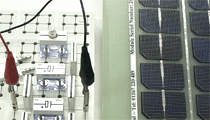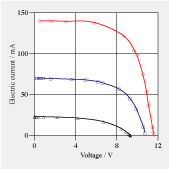CHAPTER 2 > ACTIVITIES > PROBLEMS > PROBLEM 8
Characteristics and maximum power point of PV cells
A small photovoltaic panel consisting of 21 cells arranged in series is exposed to sunlight. (The surface area of a single cell is about 15 cm^2.) It is connected to a load resistor with variable resistance.Voltage and electric current for the load resistor have been measured for different values of the resistance (see graph). Irradiation was about 60 W/m^2 for the first, 200 W/m^2 for the second, and nearly 400 W/m^2 for the third (the highest) curve. | |


